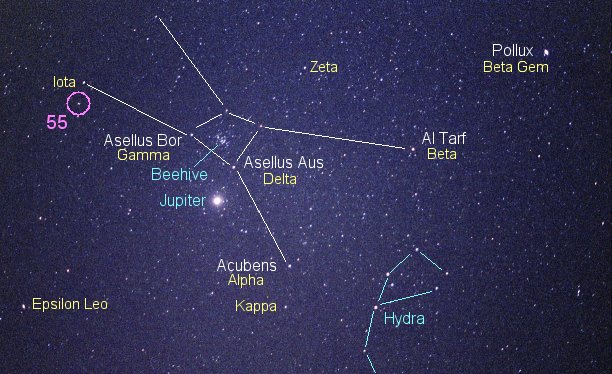 The circle shows the location of the class G star 55 Cancri (in the
constellation Cancer), also known as Rho-1
Cancri (the "55" a Flamsteed
number). The circle is actually centered on two stars
that are not separated at the photo's resolution. The eastern one
is 55 Cancri, the western 53 Cancri. (The bright body is our own
Jupiter, which was passing through Cancer when the picture was
taken.) Five planets are now known to orbit 55 Cancri (Cnc),
making it appear rather like our own Solar System. In addition,
the star has a distant red dwarf companion.
The circle shows the location of the class G star 55 Cancri (in the
constellation Cancer), also known as Rho-1
Cancri (the "55" a Flamsteed
number). The circle is actually centered on two stars
that are not separated at the photo's resolution. The eastern one
is 55 Cancri, the western 53 Cancri. (The bright body is our own
Jupiter, which was passing through Cancer when the picture was
taken.) Five planets are now known to orbit 55 Cancri (Cnc),
making it appear rather like our own Solar System. In addition,
the star has a distant red dwarf companion.
THE PLANETS
The planets are labelled "b" through "f" (where "A" is the star) in
order of discovery. Farthest out, at 5.76 Astronomical Units (AU)
from the star, is the most massive, 55 Cnc-d, which is at least 3.8
times the mass of Jupiter and takes 14.3 years to orbit. The other
four are much closer and less massive. Next closest in order are
55 Cnc f, c, b, and e with minimum masses of 0.14, 0.17, 0.82,
0.027 Jupiters, orbital radii of 0.78, 0.24, 0.115, 0.0156 AU, and
periods of 260, 44.3, 14.7, and 0.7365 days (just 17 hours and 24
minutes). 55 Cnc-e has the smallest measured minimum mass, only
that of 8.6 Earths, less than 2/3 or that of Uranus or Neptune, its
orbit just 4 percent the size that of Mercury. This innermost
planet is close enough to transit its star. From the drop in
intensity, we find a radius of between 0.6 and 0.8 times that of
Earth, which makes this "superearth" remarkably dense, at the lower
limit perhaps as dense as iron.
THE STAR
55 Cancri is a mid-sixth magnitude star (magnitude 5.95)
class G (G8) dwarf 41 light years away. A bit cooler (5280 Kelvin)
and carrying just under a solar mass, it shines at just 58 percent
of the luminosity of the Sun, its radius 0.9
solar. Like most stars with planets, 55 Cnc is rich in metals, its
iron content (relative to hydrogen) quite high, twice that of the
Sun. 55 Cancri is also a double
star . Moving along with it through space is a dim 13th
magnitude (13.7) class M red dwarf (probably M6) that is at least
1040 AU away and takes at least 30,000 years to orbit. From 55
Cancri's planets, the neighbor would shine somewhat dimmer than
Venus at her maximum as seen from Earth.
|
 The circle shows the location of the class G star 55 Cancri (in the
constellation Cancer), also known as Rho-1
Cancri (the "55" a Flamsteed
number). The circle is actually centered on two stars
that are not separated at the photo's resolution. The eastern one
is 55 Cancri, the western 53 Cancri. (The bright body is our own
Jupiter, which was passing through Cancer when the picture was
taken.) Five planets are now known to orbit 55 Cancri (Cnc),
making it appear rather like our own Solar System. In addition,
the star has a distant red dwarf companion.
The circle shows the location of the class G star 55 Cancri (in the
constellation Cancer), also known as Rho-1
Cancri (the "55" a Flamsteed
number). The circle is actually centered on two stars
that are not separated at the photo's resolution. The eastern one
is 55 Cancri, the western 53 Cancri. (The bright body is our own
Jupiter, which was passing through Cancer when the picture was
taken.) Five planets are now known to orbit 55 Cancri (Cnc),
making it appear rather like our own Solar System. In addition,
the star has a distant red dwarf companion.